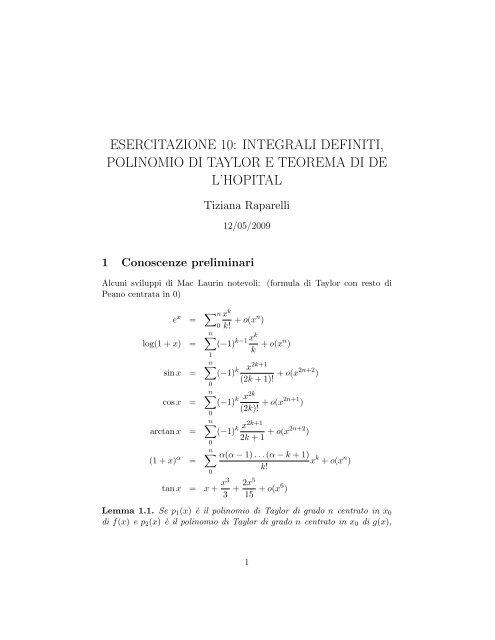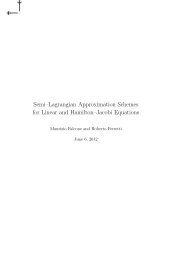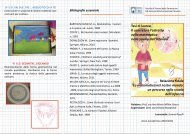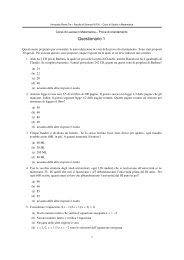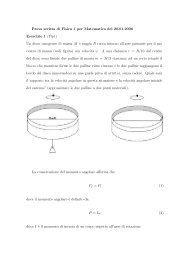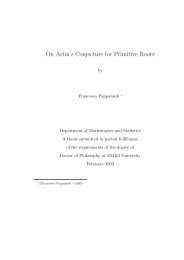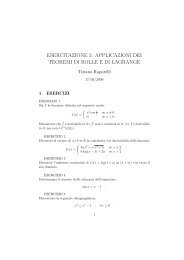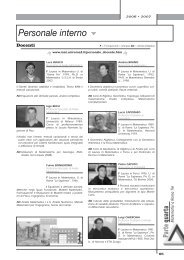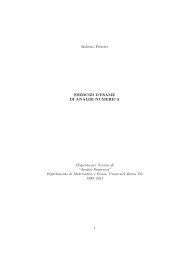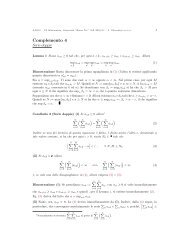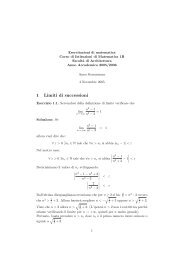esercitazione 10: integrali definiti, polinomio di taylor e teorema di ...
esercitazione 10: integrali definiti, polinomio di taylor e teorema di ...
esercitazione 10: integrali definiti, polinomio di taylor e teorema di ...
You also want an ePaper? Increase the reach of your titles
YUMPU automatically turns print PDFs into web optimized ePapers that Google loves.
ESERCITAZIONE <strong>10</strong>: INTEGRALI DEFINITI,<br />
POLINOMIO DI TAYLOR E TEOREMA DI DE<br />
L’HOPITAL<br />
Tiziana Raparelli<br />
12/05/2009<br />
1 Conoscenze preliminari<br />
Alcuni sviluppi <strong>di</strong> Mac Laurin notevoli: (formula <strong>di</strong> Taylor con resto <strong>di</strong><br />
Peano centrata in 0)<br />
e x = ∑ n x k<br />
0 k! + o(xn )<br />
n∑<br />
k−1 xk<br />
log(1 + x) = (−1)<br />
k + o(xn )<br />
sin x =<br />
cos x =<br />
arctan x =<br />
(1 + x) α =<br />
1<br />
n∑<br />
0<br />
n∑<br />
0<br />
n∑<br />
0<br />
n∑<br />
0<br />
(−1) k x 2k+1<br />
(2k + 1)! + o(x2n+2 )<br />
(−1) k x2k<br />
(2k)! + o(x2n+1 )<br />
(−1) k x2k+1<br />
2k + 1 + o(x2n+2 )<br />
α(α − 1) . . . (α − k + 1)<br />
x k + o(x n )<br />
k!<br />
tan x = x + x3<br />
3 + 2x5<br />
15 + o(x6 )<br />
Lemma 1.1. Se p 1 (x) è il <strong>polinomio</strong> <strong>di</strong> Taylor <strong>di</strong> grado n centrato in x 0<br />
<strong>di</strong> f(x) e p 2 (x) è il <strong>polinomio</strong> <strong>di</strong> Taylor <strong>di</strong> grado n centrato in x 0 <strong>di</strong> g(x),<br />
1
allora<br />
Lemma 1.2. Sia<br />
p T (f + g)(x) = p 1 (x) + p 2 (x) (1)<br />
p T (fg)(x) = p 1 (x)p 2 (x) (2)<br />
p T (x) =<br />
n∑<br />
k=0<br />
f (k) (x 0 )<br />
(x − x 0 ) n<br />
k!<br />
il <strong>polinomio</strong> <strong>di</strong> Taylor <strong>di</strong> f(x) centrato in x 0 <strong>di</strong> or<strong>di</strong>ne n. Allora<br />
i) Il <strong>polinomio</strong> <strong>di</strong> Taylor <strong>di</strong> or<strong>di</strong>ne n − 1 centrato in x 0 <strong>di</strong> f ′ (x) è<br />
p T<br />
(<br />
f ′ (x) ) = p ′ T (f(x)) =<br />
n∑<br />
k=0<br />
f (k) (x 0 )<br />
(k − 1)! (x − x 0) k−1 . (3)<br />
ii) Sia F (x) una primitiva <strong>di</strong> f(x). Allora il <strong>polinomio</strong> <strong>di</strong> Taylor <strong>di</strong> grado<br />
n + 1 centrato in x 0 <strong>di</strong> F (x) è dato da<br />
p T<br />
(<br />
F (x)<br />
)<br />
=<br />
∫<br />
2 ESERCIZI<br />
p T ((f(x) ) dx = F (x 0 ) +<br />
n∑<br />
k=0<br />
f (k) (x 0 )<br />
(k + 1)! (x − x 0) k+1 (4)<br />
ESERCIZIO 1<br />
Calcolare l’area <strong>di</strong> R dove R è la regione <strong>di</strong> area maggiore compresa tra la<br />
funzione f(x) = √ |x| e la circonferenza unitaria centrata nell’origine.<br />
ESERCIZIO 2<br />
Calcolare i seguenti limiti<br />
(a)<br />
(b)<br />
(c)<br />
∫<br />
1 x<br />
lim<br />
x→0 x 3 (e t2 − 1)dt<br />
0<br />
∫<br />
1 x 2<br />
lim<br />
x→0 x 4 log(1 + sin t)dt<br />
0<br />
lim (sin x)<br />
x→<br />
π<br />
2<br />
1<br />
cos 2 x<br />
ESERCIZIO 3<br />
Scrivere i polinomi <strong>di</strong> Taylor <strong>di</strong> or<strong>di</strong>ne n delle seguenti funzioni, in un intorno<br />
2
del punto in<strong>di</strong>cato.<br />
(a) f(x) = x cos(x 2 ) x 0 = 0<br />
(b) f(x) = 3√ x x 0 = 1<br />
(c) f(x) = x<br />
1 + x 2 x 0 = 0<br />
(d) f(x) = arctan x x 0 = 0 .<br />
ESERCIZIO 4<br />
Sia f una funzione limitata e integrabile nell’intervallo [0, 5] tale che<br />
∫ 5<br />
0<br />
f(x)dx = <strong>10</strong> .<br />
Dimostrare che:<br />
a) esiste almeno un punto x 0 ∈ [0, 5] t.c. f(x 0 ) < 3<br />
b) se f(x) ∈ C 0 ([0, 5]), allora esiste almeno un punto x 0 ∈ [0, 5] t.c.<br />
3 SOLUZIONI<br />
ESERCIZIO 1<br />
f(x 0 ) = 2 .<br />
2.4<br />
1.6<br />
0.8<br />
-4.8 -4 -3.2 -2.4 -1.6 -0.8 0 0.8 1.6 2.4 3.2 4 4.8<br />
-0.8<br />
-1.6<br />
-2.4<br />
Figura 1: La regione R<br />
Sia S l’altra regione delimitata dai grafici delle curve date. È conveniente<br />
calcolare l’area <strong>di</strong> S e sottrarla all’area del cerchio unitario. La<br />
semicirconferenza superiore `descritta dall’equazione<br />
y = √ 1 − x 2<br />
3
e l’intersezione con f(x), per x > 0, è la soluzione (positiva) del sistema<br />
√<br />
1 − x 2 = √ x<br />
cioè è il punto a = −1+√ 5<br />
2<br />
. Poiché entrambe le funzioni sono pari, l’area<br />
cercata è pari a<br />
A(S) = 2<br />
∫ a<br />
= | x=sin t 2 (∫ arcsin a<br />
Dunque l’area della regione cercata è<br />
=<br />
0<br />
0<br />
(√<br />
1 − x 2 − √ x ) dx<br />
cos 2 tdt − 2 3 x 3<br />
2 ∣ a )<br />
0<br />
[<br />
sin t cos t + t<br />
] arcsin a<br />
0<br />
− 4 3 a 3 2<br />
= 2a cos(arcsin a) + arcsin a − 4 3 a 3 2<br />
= 2a √ 1 − a 2 + arcsin a − 4 3 a 3 2 .<br />
A(R) = π − A(S) .<br />
ESERCIZIO 2<br />
(a) È una forma indeterminata del tipo [ 0<br />
0]<br />
, applichiamo il <strong>teorema</strong> fondamentale<br />
del calcolo integrale e il <strong>teorema</strong> <strong>di</strong> De l’Hopital:<br />
lim<br />
x→0<br />
(b) Come nel caso (a) ,<br />
∫<br />
1 x<br />
e x2 − 1<br />
x 3 (e t2 − 1)dt = lim<br />
x→0 3x 2 = 1 3<br />
0<br />
.<br />
lim<br />
x→0<br />
∫<br />
1 x 2<br />
log(1 + sin x 2 )2x<br />
x 4 log(1 + sin t)dt = lim<br />
0<br />
x→0 4x 3<br />
log(1 + sin x 2 ) 2x sin x 2<br />
= lim<br />
x→0 sin x 2 4x 3 = 1 2<br />
(c) Forma indeterminata [1 ∞ ]<br />
sin x 1<br />
cos 2 x = e 1<br />
cos 2 x log(sin x) ,<br />
.<br />
e<br />
lim<br />
x→ π 2<br />
1<br />
cos 2 x log(sin x) = [0 0 ] .<br />
4
Applicando il <strong>teorema</strong> <strong>di</strong> De L’Hopital<br />
lim<br />
x→ π 2<br />
log(sin x)<br />
cos 2 x<br />
cos x<br />
= lim<br />
x→<br />
π<br />
sin x · (− 1<br />
2 cos x sin x ) ,<br />
2<br />
quin<strong>di</strong> il limite dato à pari a e − 1 2 .<br />
ESERCIZIO 3<br />
(a) Considerando il <strong>polinomio</strong> <strong>di</strong> Taylor <strong>di</strong> grado n centrato in 0 <strong>di</strong> cos t e<br />
sostituendo t → x 2 , si ha che<br />
e<br />
p T (cos x 2 ) =<br />
p T (x cos x 2 ) =<br />
n∑<br />
k→0<br />
n∑<br />
k→0<br />
(−1) k x4k<br />
(2k)!<br />
(−1) k x4k+1<br />
(2k)!<br />
avendo usato (2) .<br />
(b) Sia y = x − 1, allora f(y) = (1 + y) 1 3 e y 0 = 0. Usando la formula <strong>di</strong><br />
Mac Laurin <strong>di</strong> (1 + y) α , con α = 1 3<br />
, otteniamo che<br />
p T (y) =<br />
n∑<br />
k=0<br />
1<br />
3 . . . (− 2 3 − k)<br />
k!<br />
e, ritornando alla variabile x, abbiamo l’espressione per il <strong>polinomio</strong> cercato:<br />
(c) Dato che<br />
p T (x) =<br />
n∑<br />
k=0<br />
1<br />
3 . . . (− 2 3 − k)<br />
k!<br />
f(x) = x ·<br />
1<br />
1 + x 2<br />
y k<br />
(x − 1) k .<br />
calcoliamo il <strong>polinomio</strong> <strong>di</strong> Taylor centrato in 0 <strong>di</strong> (1 + x 2 ) −1 e poi lo moltiplichiamo<br />
per x.<br />
e<br />
p ( (1 + x 2 ) −1) =<br />
n∑<br />
k=0<br />
p(f(x)) =<br />
(−1) . . . −k<br />
x 2k =<br />
k!<br />
n∑<br />
(−1) k x 2k+1 .<br />
k=0<br />
5<br />
n∑<br />
(−1) k x 2k<br />
k=0
(d) Poiché arctan x è una primitiva <strong>di</strong><br />
1<br />
1+x 2 (e arctan(0) = 0), allora usando<br />
il lemma 1.2 si ottiene il <strong>polinomio</strong> <strong>di</strong> Taylor dell’arctan x integrando termine<br />
a termine il <strong>polinomio</strong> <strong>di</strong> Taylor <strong>di</strong><br />
1<br />
1+x 2 , cioè<br />
p T (arctan x) =<br />
n∑<br />
k=0<br />
(−1) k x2k+1<br />
2k + 1<br />
.<br />
ESERCIZIO 4<br />
a) Supp. per assurdo f(x) ≥ 3 per ogni x ∈ [0, 5], allora risulterebbe<br />
∫ 5<br />
0<br />
f(x)dx ≥<br />
∫ 5<br />
0<br />
3dx = 15 .<br />
b) Per il <strong>teorema</strong> della me<strong>di</strong>a, essendo f continua, esiste x 0 ∈ [0, 5] t.c.<br />
da cui segue la tesi.<br />
<strong>10</strong> =<br />
∫ 5<br />
0<br />
f(x)dx = 5f(x 0 )<br />
6


